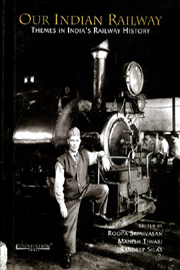Book contents
- Frontmatter
- Contents
- Foreword
- Preface
- Introduction
- 1 The Colonial Context of the Bengal Renaissance: A Note on Early Railway–Thinking in Bengal
- 2 Minute by Dalhousie on Introduction of Railways in India, as Submitted to the Court of Directors, 4 July 1850
- 3 Ackworth Committee Report
- 4 Competition and Adaptation: The Operation of Railways in Northern India: Uttar Pradesh 1860–1914
- 5 Economic Nationalism and the Railway Debate, circa 1880-1905
- 6 Railway Policing and Security in Colonial India, c. 1860–1930
- 7 Indian Nationalism and Railways
- 8 The Railway in Colonial India: Between Ideas and Impacts
- 9 The Dark Side of the Force: Mistakes, Mismanagement and the Malfeasance in Early Railways of the British Indian Empire
- 10 Tunnels and Bridges: Railways, Narrative and Power in two Novels of India
- 11 A View of the History of Indian Railways
- 12 The Romance of Steam
- Index
- Plate section
Introduction
Published online by Cambridge University Press: 26 October 2011
- Frontmatter
- Contents
- Foreword
- Preface
- Introduction
- 1 The Colonial Context of the Bengal Renaissance: A Note on Early Railway–Thinking in Bengal
- 2 Minute by Dalhousie on Introduction of Railways in India, as Submitted to the Court of Directors, 4 July 1850
- 3 Ackworth Committee Report
- 4 Competition and Adaptation: The Operation of Railways in Northern India: Uttar Pradesh 1860–1914
- 5 Economic Nationalism and the Railway Debate, circa 1880-1905
- 6 Railway Policing and Security in Colonial India, c. 1860–1930
- 7 Indian Nationalism and Railways
- 8 The Railway in Colonial India: Between Ideas and Impacts
- 9 The Dark Side of the Force: Mistakes, Mismanagement and the Malfeasance in Early Railways of the British Indian Empire
- 10 Tunnels and Bridges: Railways, Narrative and Power in two Novels of India
- 11 A View of the History of Indian Railways
- 12 The Romance of Steam
- Index
- Plate section
Summary
We called this book ‘Our Indian Railway’ as a deliberate echo of a term used in 1847 by R.M. Stephenson, the famous railway builder and entrepreneur when reviewing a series of reports arguing for the development of railways in India. His use of the possessive pronoun, used almost as an endearment, might seem odd but not unusual for something as prosaic as a structure made of mortar and steel, since it is true that railways have often evoked strong emotions of possession and affection. At the time that Stephenson wrote of ‘Our Indian Railway’ the project to unite what would be the largest territory of the empire with a railway system was certainly a notion dear to his heart, both as a creative engineer and businessman, but also as a man who shared imperial ambitions about India. In 1847, the Indian railway system was still only an idea, at a time when the idea of ‘India’ as an integrated political unit also remained very much an imaginary notion. But when India did eventually take shape as a definable political unit under the British Crown and then in 1947 as an independent republic, it was really the railway that bound the country together. Railways made India a working and recognizable structure and political and economic entity, at a time when many other forces militated against unity. Through their own internal logic, their transformation of speed and the new dynamic of the economic changes they made possible, the railways definitively altered the Indian way of life, irrespective of the plans of politicians or the ambitions of entrepreneurs.
- Type
- Chapter
- Information
- Our Indian RailwayThemes in India's Railway History, pp. xiii - xxxivPublisher: Foundation BooksPrint publication year: 2006

